Automatic Speech Recognition of Public Safety Radio Communications for Interstate Incident Detection and Notification
Highlights
- Modern Automatic Speech Recognition models are capable of transcribing 9-1-1 dispatch communications with usable accuracy.
- Commercial products for recording, transcribing, and disseminating information from 9-1-1 dispatch communications promptly for Traffic Incident Management.
- Using existing products and software, Traffic Management Centers can expand their effective coverage to more rural segments by automatically relaying regional 9-1-1 dispatch broadcasts to a central source.
Abstract
1. Introduction
1.1. Problem Statement
1.2. Document Overview
2. Background
2.1. Incident Detection Literature
2.2. Public Safety Radio Communications
2.3. Automatic Speech Recognition
2.4. Traffic Management Centers and Traffic Incident Management
2.5. Related Work: Integrating Public Safety Radio with Automatic Speech Recognition
2.6. Study Location
3. Description of Incident Used for Case Study
9-1-1 Dispatch Audio and Transcribed Text for Truck Fire Incident
- Location confirmation at 15:09 to be at a specific exit.
- The closure of travel lanes at 15:13.
- The opening of travel lanes at 15:28.
- The scene cleared at 15:45.
4. Methodology
4.1. System Integration Architecture
- I.
- Audio transmission.
- II.
- Audio capture.
- III.
- Audio transcription and keyword extraction.
- IV.
- Notification and action.
4.2. Capturing Audio
4.3. Transcribing Audio
4.4. Keyword Extraction and Notification
- “Interstate” keywords refer to specific references to an interstate. For the study location, the only interstate of interest is I-65; hence, the examples are limited to I-65 (including the local phrase “the I”). “Interstate” keywords serve as the primary indicator of an incident occurring on the interstate.
- “Location” keywords refer to a particular location along the interstate. The desired “location” is the MM (e.g., ‘168.5’); however, sufficient information is contained within specific exits/entrances to infer most locations along a given route. Additional context, including which lane or shoulder, is also considered valuable as it will expedite the locating time for a TMC operator.
- “Incident” keywords refer to additional context about the specific incident (e.g., ‘fire’ or ‘crash’). These keywords help indicate the type and severity of the incident.
5. Results
6. Case Study & Discussion
6.1. Automated Notification
6.2. Spatiotemporal Heatmaps
- The incident occurred at MM 165.8, northbound (callout vii).
- The longest queue reached MM 156.1, an estimated 9.6-mile queue (callout vi).
- The incident began at 14:59 (callout vii).
- There is a short-term NB closure at approximately 15:22 near MM 165.8 (callout ix). The transcribed text for this can be seen in Table 1 at 15:22:08, and the lack of vehicles passing through this area is shown as the white area on the northbound heatmap at this approximate time.
- The incident cleared at 15:45 (callout viii).
- There were two ITS cameras near the incident (callout x and callout xi).
- The queue reached the upstream camera (callout xi) and cleared the same, as shown by callout xii and xiii, respectively.
- ITS images from those cameras are shown in Figure 10 and are described in more detail below.
6.3. ITS Camera Images
- (a)
- Incident occurrence, see the capture time (callout i).
- (b)
- A fire engine entered the southbound lanes (callout ii, being the same as Table 1, row “15:08:20”). Vehicles are traveling in the northbound lanes (callout iii) at nine minutes after the incident starts.
- (c)
- Full closure of the northbound lanes at twenty minutes after the incident starts.
- (d)
- Northbound lanes reopened thirty-one minutes after the incident started (callout iv).
- (e)
- Upstream camera captures the queue exceeding its location (callout v) at fifty-seven minutes after the incident occurs.
- (f)
- The queue clears the upstream camera (callout vi) at eighty-four minutes after the incident starts.
6.4. Enhancing TMC Incident Awareness of Remote Incidents with Dispatch Audio
7. Conclusions
Future Opportunities
Author Contributions
Funding
Data Availability Statement
Acknowledgments
Conflicts of Interest
Correction Statement
References
- INDOT Condition Acquisition and Reporting System (CARS) & TMC Reporting Policy 2021. Available online: https://www.in.gov/indot/files/INDOT_CARS_Policy.pdf (accessed on 1 July 2025).
- 511 Deployment Coalition (U.S.). America’s Travel Information Number: Implementation and Operational Guidelines for 511 Services 2005; 511 Deployment Coalition (U.S.): Washington, DC, USA, 2005. [Google Scholar]
- Burgess, L.M.; Garinger, A.; Carrick, G. Integrating Computer-Aided Dispatch Data with Traffic Management Centers; Cambridge Systematics, Inc.: Medford, MA, USA, 2021. [Google Scholar]
- Judycki, D.C.; Robinson, J.R. Managing Traffic during Nonrecurring Congestion. ITE J. 1992, 1992, 21–26. [Google Scholar]
- Transportation Research Board. Better Use of Existing Transportation Facilities. In Proceedings of the Seventh Summer Meeting of the Transportation Research Board in Cooperations with the Florida Department of Transportation, Jacksonville, FL, USA, 5–7 August 1974; Transportation Research Board National Research Council: Jacksonville, FL, USA, 1975.
- Cook, A.R.; Cleveland, D.E. The Detection of Freewauy Capactiy Reducing Incidents by Traffic Stream Measurements. In Optimizing Freeway Corridor Operations Through Traffic Surveillance, Communication and Control; The University of Michigan, Highway Safety Research Institute: Ann Arbor, MI, USA, 1970. [Google Scholar]
- Payne, H.J. Freeway iIncident Detection Based Upon Pattern Classification. In Proceedings of the 1975 IEEE Conference on Decision and Control including the 14th Symposium on Adaptive Processes, Houston, TX, USA, 10–12 December 1975; pp. 688–692. [Google Scholar]
- Willsky, A.; Chow, E.; Gershwin, S.; Greene, C.; Houpt, P.; Kurkjian, A. Dynamic Model-Based Techniques for the Detection of Incidents on Freeways. IEEE Trans. Autom. Control 1980, 25, 347–360. [Google Scholar] [CrossRef]
- Cheu, R.L.; Ritchie, S.G. Automated Detection of Lane-Blocking Freeway Incidents Using Artificial Neural Networks. Transp. Res. Part C Emerg. Technol. 1995, 3, 371–388. [Google Scholar] [CrossRef]
- Gangisetty, R. Advanced Traffic Management System on I-476 in Pennsylvania. In Proceedings of the Conference on Intelligent Transportation Systems, Boston, MA, USA, 12 November 1997; pp. 373–378. [Google Scholar]
- Champion, H.R.; Augenstein, J.; Blatt, A.J.; Cushing, B.; Digges, K.; Siegel, J.H.; Flanigan, M.C. Automatic Crash Notification and the URGENCY Algorithm. Adv. Emerg. Nurs. J. 2004, 26, 143–156. [Google Scholar]
- Oh, J.-S.; Oh, C.; Ritchie, S.G.; Chang, M. Real-Time Estimation of Accident Likelihood for Safety Enhancement. J. Transp. Eng. 2005, 131, 358–363. [Google Scholar] [CrossRef]
- Alexander, L.; Cheng, P.-M.; Gorjestani, A.; Menon, A.; Newstrom, B.; Shankwitz, C.; Donath, M. The Minnesota Mobile Intersection Surveillance System. In Proceedings of the 2006 IEEE Intelligent Transportation Systems Conference, Toronto, ON, Canada, 17–20 September 2006; pp. 139–144. [Google Scholar]
- Oh, C.; Park, S.; Ritchie, S.G. A Method for Identifying Rear-End Collision Risks Using Inductive Loop Detectors. Accid. Anal. Prev. 2006, 38, 295–301. [Google Scholar] [CrossRef] [PubMed]
- Thompson, C.; White, J.; Dougherty, B.; Albright, A.; Schmidt, D.C. Using Smartphones to Detect Car Accidents and Provide Situational Awareness to Emergency Responders. In Mobile Wireless Middleware, Operating Systems, and Applications; Cai, Y., Magedanz, T., Li, M., Xia, J., Giannelli, C., Eds.; Springer: Berlin/Heidelberg, Germany, 2010; pp. 29–42. [Google Scholar]
- Gongjun, Y.; Olariu, S.; Popescu, D.C. NOTICE: An Architecture for the Notification of Traffic Incidents. IEEE Intell. Transp. Syst. Mag. 2012, 4, 6–16. [Google Scholar] [CrossRef]
- Junior, J.G.R.; Campista, M.E.M.; Costa, L.H.M.K. A Decentralized Traffic Monitoring System Based on Vehicle-to-Infrastructure Communications. In 2013 IFIP Wireless Days (WD); IEEE: Valencia, Spain, 2013; pp. 1–6. [Google Scholar]
- Foggia, P.; Saggese, A.; Strisciuglio, N.; Vento, M.; Petkov, N. Car Crashes Detection by Audio Analysis in Crowded Roads. In Proceedings of the 2015 12th IEEE International Conference on Advanced Video and Signal Based Surveillance (AVSS), Karlsruhe, Germany, 25–28 August 2015; pp. 1–6. [Google Scholar]
- Almaadeed, N.; Asim, M.; Al-Maadeed, S.; Bouridane, A.; Beghdadi, A. Automatic Detection and Classification of Audio Events for Road Surveillance Applications. Sensors 2018, 18, 1858. [Google Scholar] [CrossRef] [PubMed]
- Apple Inc. Use Crash Detection on iPhone or Apple Watch to Call for Help in an Accident. Available online: https://support.apple.com/en-us/104959 (accessed on 17 July 2025).
- Senarath, Y.; Nannapaneni, S.; Purohit, H.; Dubey, A. Emergency Incident Detection from Crowdsourced Waze Data Using Bayesian Information Fusion. In Proceedings of the 2020 IEEE/WIC/ACM International Joint Conference on Web Intelligence and Intelligent Agent Technology (WI-IAT), Melbourne, Australia, 14–17 December 2020; pp. 187–194. [Google Scholar]
- Pan, D.; Hamdar, S. From Traffic Analysis to Real-Time Management: A Hazard-Based Modeling for Incident Durations Extracted Through Traffic Detector Data Anomaly Detection. Transp. Res. Rec. 2024, 2678, 389–400. [Google Scholar] [CrossRef]
- Xiao, D.; Wang, Z.; Shen, Z.; Xu, X.; Ma, C. A FairMOT Approach Based on Video Recognition for Real-Time Automatic Incident Detection on Expressways. Signal Image Video Process. 2024, 18, 7333–7348. [Google Scholar] [CrossRef]
- ElSahly, O.; Abdelfatah, A. Developing a Machine-Learning-Based Automatic Incident Detection System for Traffic Safety: Promises and Limitations. Infrastructures 2024, 9, 170. [Google Scholar] [CrossRef]
- Zdunek, K. Design Considerations of Trunked Radio Systems. In Proceedings of the 36th IEEE Vehicular Technology Conference, Dallas, TX, USA, 20–22 May 1986; Volume 36, pp. 194–201. [Google Scholar]
- Jones, L.T. Trunked Radio Systems; U.S. Department of Justice, Office of Justice Programs, National Institute of Justice, Technology Assessment Program: Washington, DC, USA, 1993. [Google Scholar]
- Trunked Radio Systems. Available online: https://wiki.radioreference.com/index.php/Trunking (accessed on 9 July 2025).
- Sharp, D.S.; Cackov, N.; Laskovic, N.; Shao, Q.; Trajkovic, L. Analysis of Public Safety Traffic on Trunked Land Mobile Radio Systems. IEEE J. Sel. Areas Commun. 2004, 22, 1197–1205. [Google Scholar] [CrossRef]
- What Is Project Hoosier SAFE-T? Available online: https://faqs.in.gov/hc/en-us/articles/115005056187-What-is-Project-Hoosier-SAFE-T (accessed on 27 May 2025).
- What Evidence Is Available Showing That the SAFE-T Network Works? Available online: https://faqs.in.gov/hc/en-us/articles/115005228848-What-evidence-is-available-showing-that-the-SAFE-T-network-works (accessed on 9 July 2025).
- About RadioReference. Available online: https://www.radioreference.com/about/ (accessed on 9 July 2025).
- Tippecanoe County (IN)—The RadioReference Wiki. Available online: https://wiki.radioreference.com/index.php/Tippecanoe_County_(IN) (accessed on 23 June 2025).
- TETRA. Available online: https://www.etsi.org/technologies/tetra (accessed on 17 September 2025).
- IBM100—Pioneering Speech Recognition. Available online: https://web.archive.org/web/20150219080748/http://www-03.ibm.com/ibm/history/ibm100/us/en/icons/speechreco/ (accessed on 9 July 2025).
- Huang, X.; Baker, J.; Reddy, R. A Historical Perspective of Speech Recognition. Commun. ACM 2014, 57, 94–103. [Google Scholar] [CrossRef]
- Ibrahim, H.; Varol, A. A Study on Automatic Speech Recognition Systems. In Proceedings of the 2020 8th International Symposium on Digital Forensics and Security (ISDFS), Beirut, Lebanon, 1–2 June 2020; pp. 1–5. [Google Scholar]
- Popović, M.; Ney, H. Word Error Rates: Decomposition over Pos Classes and Applications for Error Analysis. In Proceedings of the Second Workshop on Statistical Machine Translation—StatMT ’07, Prague, Czech Republic, 23 June 2007; Association for Computational Linguistics: Prague, Czech Republic, 2007; pp. 48–55. [Google Scholar]
- Wang, Y.-Y.; Acero, A.; Chelba, C. Is Word Error Rate a Good Indicator for Spoken Language Understanding Accuracy. In Proceedings of the 2003 IEEE Workshop on Automatic Speech Recognition and Understanding, St. Thomas, VI, USA, 30 November–4 December 2003; pp. 577–582. [Google Scholar]
- Stehr, R.A. Minnesota Department of Transportation Experience in the Application of Advanced Traffic Management Systems; ASCE: Minneapolis, MN, USA, 1991; pp. 458–462. [Google Scholar]
- Sakhare, R.S.; Desai, J.; Woker, W.; Li, H.; Mathew, J.K.; Mahlberg, J.; Saldivar-Carranza, E.D.; Horton, D.; Bullock, D.M.; United States Department of Transportation. Intelligent Transportation Systems Joint Program Office; et al. Connected Vehicle-Centric Dashboards for TMC of the Future; SPR-4396; Purdue Universityl: West Lafayette, IN, USA, 2023; p. 41. [Google Scholar]
- Stein, D.; Krausz, B.; Löffler, J.; Marterer, R.; Bardeli, R.; Schwenninger, J.; Usabaev, B. Enriching an Intelligent Resource Management System with Automatic Event Recognition. In Proceedings of the 9th International ISCRAM Conference, Vancouver, BC, Canada, 22–25 April 2012. [Google Scholar]
- Stein, D.; Schwenninger, J.; Usabaev, B. Automatic Chat Transcription on a Firefighter TETRA Broadcast Channel. In Proceedings of the Speech Communication, 10. ITG Symposium, Braunschweig, Germany, 26–28 September 2012; pp. 1–4. [Google Scholar]
- Bochner, J.; Indelicato, M.; Konnur, P. Effects of Sound Quality on the Accuracy of Telephone Captions Produced by Automatic Speech Recognition: A Preliminary Investigation. Am. J. Audiol. 2023, 32, 243–250. [Google Scholar] [CrossRef] [PubMed]
- Srivastava, T.; Chou, J.-C.; Shroff, P.; Livescu, K.; Graziul, C. Speech Recognition for Analysis of Police Radio Communication. In Proceedings of the 2024 IEEE Spoken Language Technology Workshop (SLT), Macao, China, 2–5 December 2024; pp. 906–912. [Google Scholar]
- Zheng, O.; Abdel-Aty, M.; Wang, D.; Wang, Z.; Ding, S. ChatGPT Is on the Horizon: Could a Large Language Model Be All We Need for Intelligent Transportation? arXiv 2023, arXiv:2303.05382. [Google Scholar]
- SDS200 Owner’s Manual. Available online: https://www.uniden.info/download/ompdf/SDS200om.pdf (accessed on 9 July 2025).
- Bob Aune ProScan. Available online: https://www.proscan.org/ (accessed on 9 July 2025).
- Openai/Whisper. Available online: https://github.com/openai/whisper (accessed on 9 July 2025).
- Sakhare, R.S.; Desai, J.; Mathew, J.K.; McGregor, J.; Kachler, M.; Bullock, D.M. Measuring and Visualizing Freeway Traffic Conditions: Using Connected Vehicle Data; Joint Transportation Research Program: West Lafayette, IN, USA, 2024. [Google Scholar]
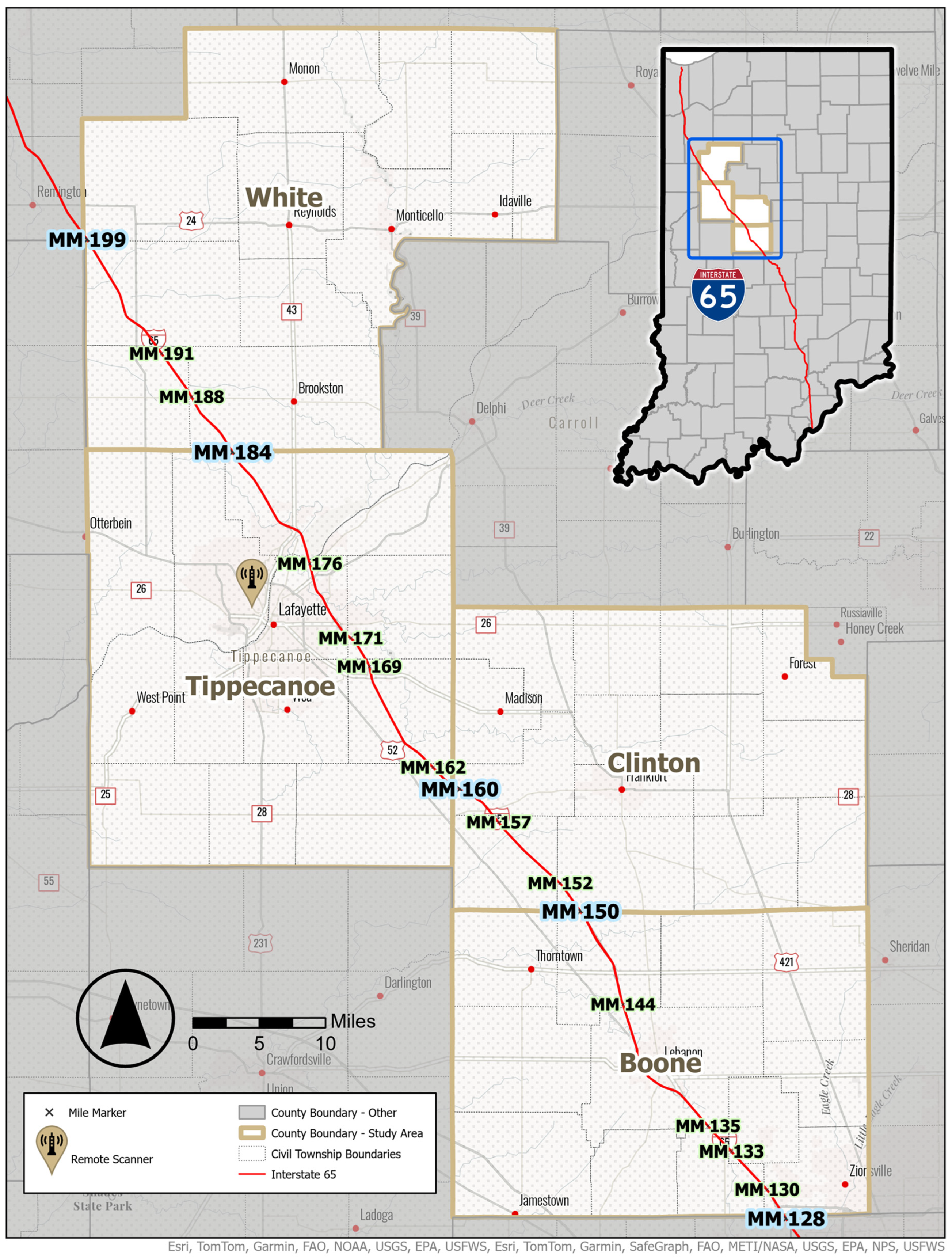
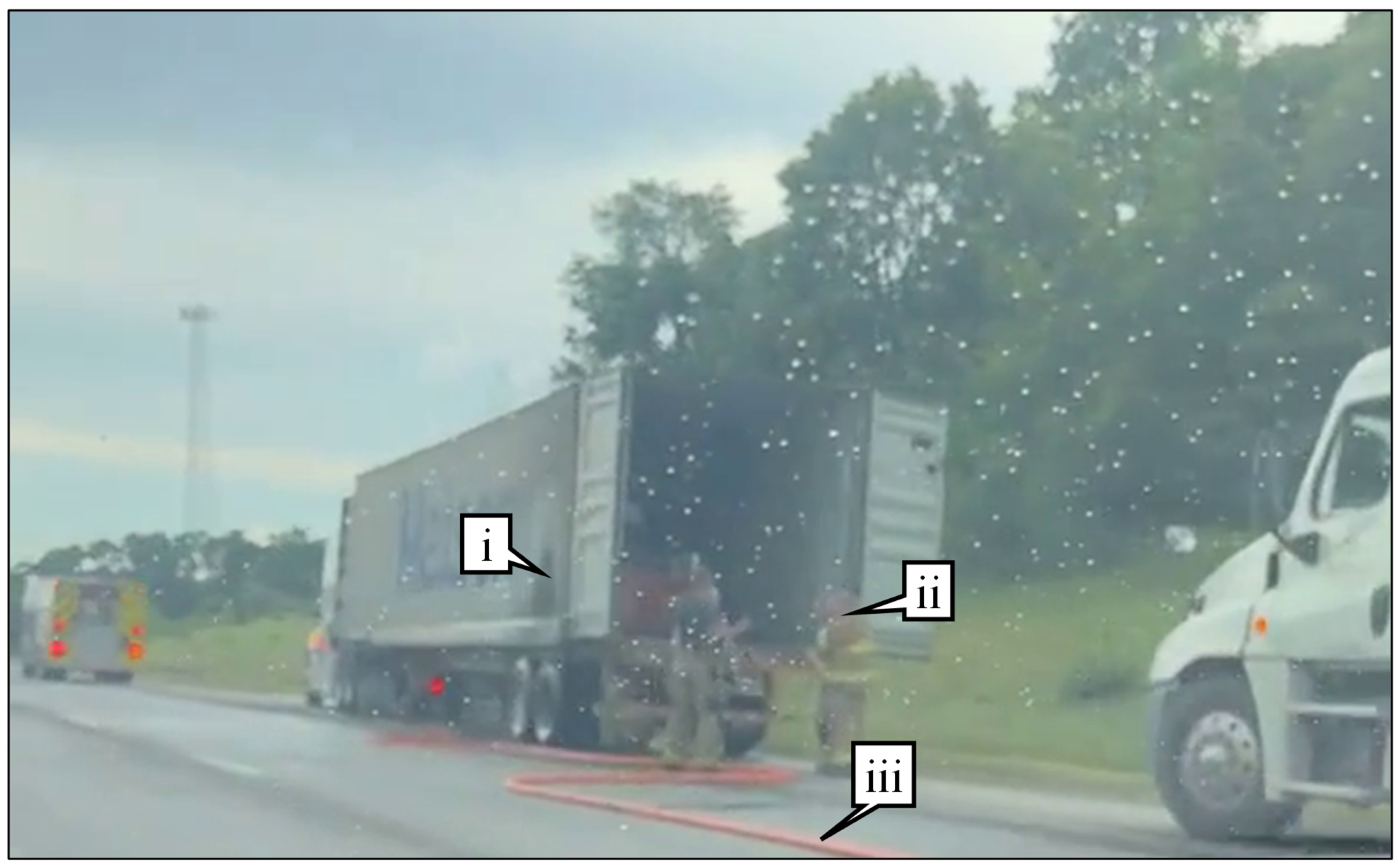
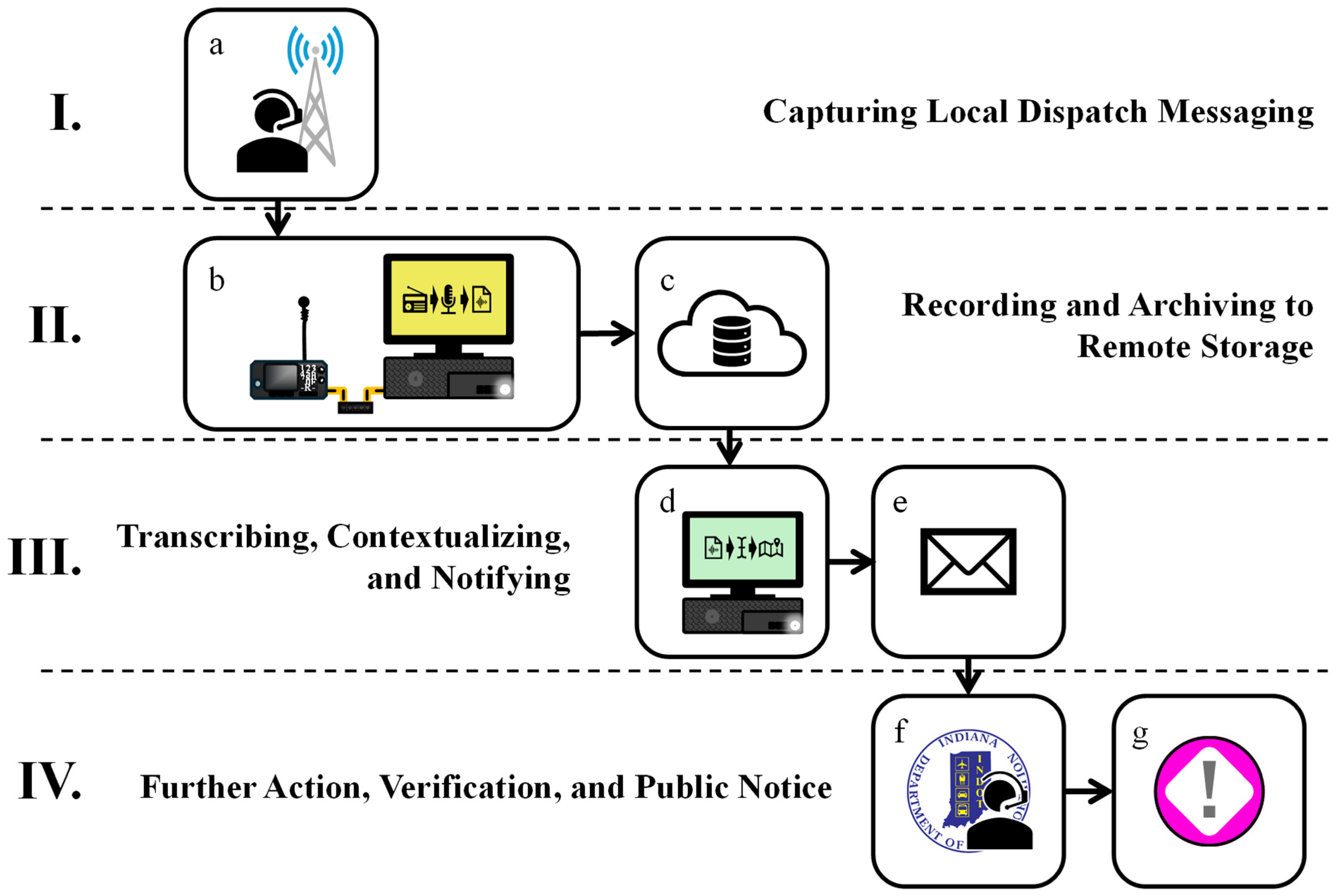
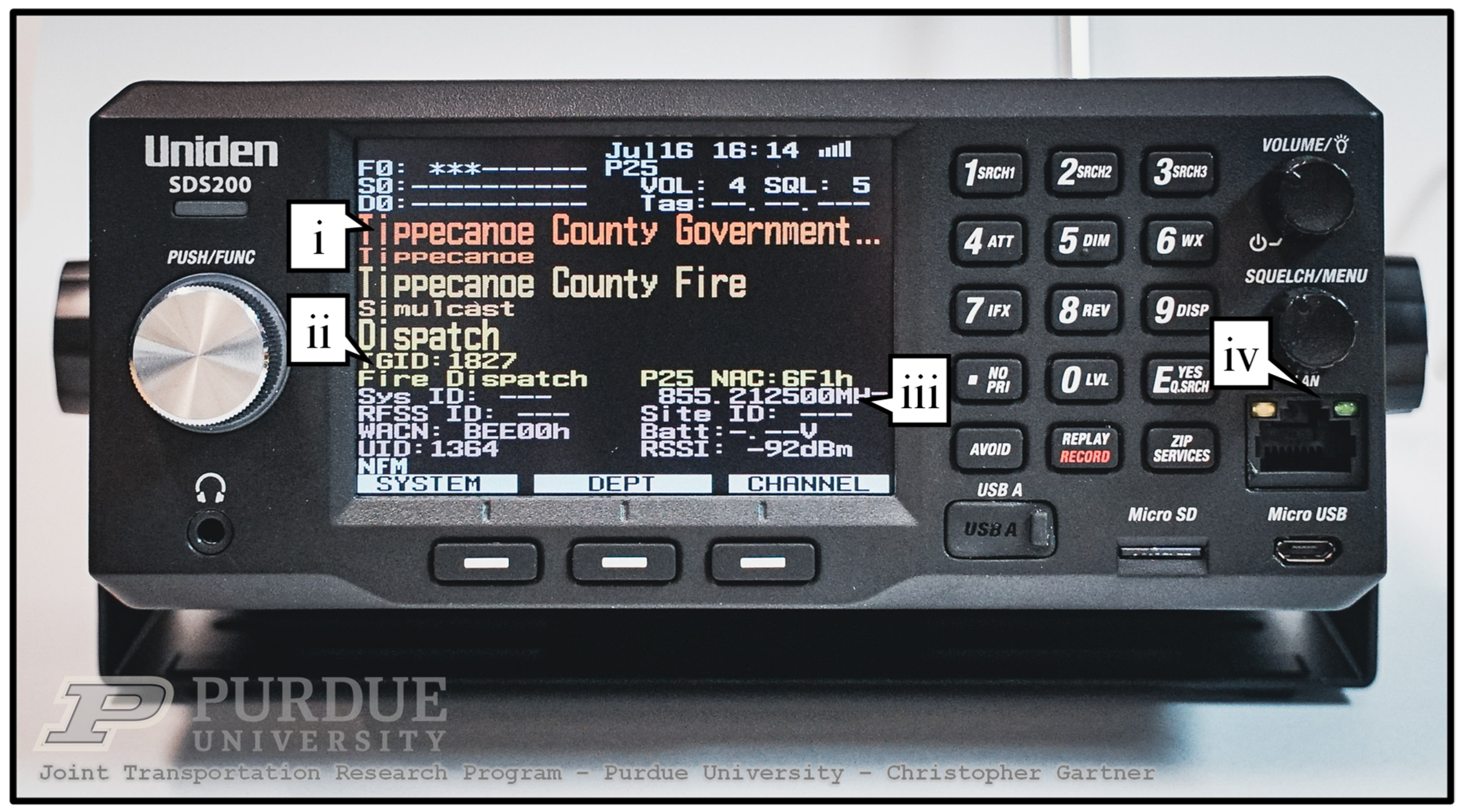

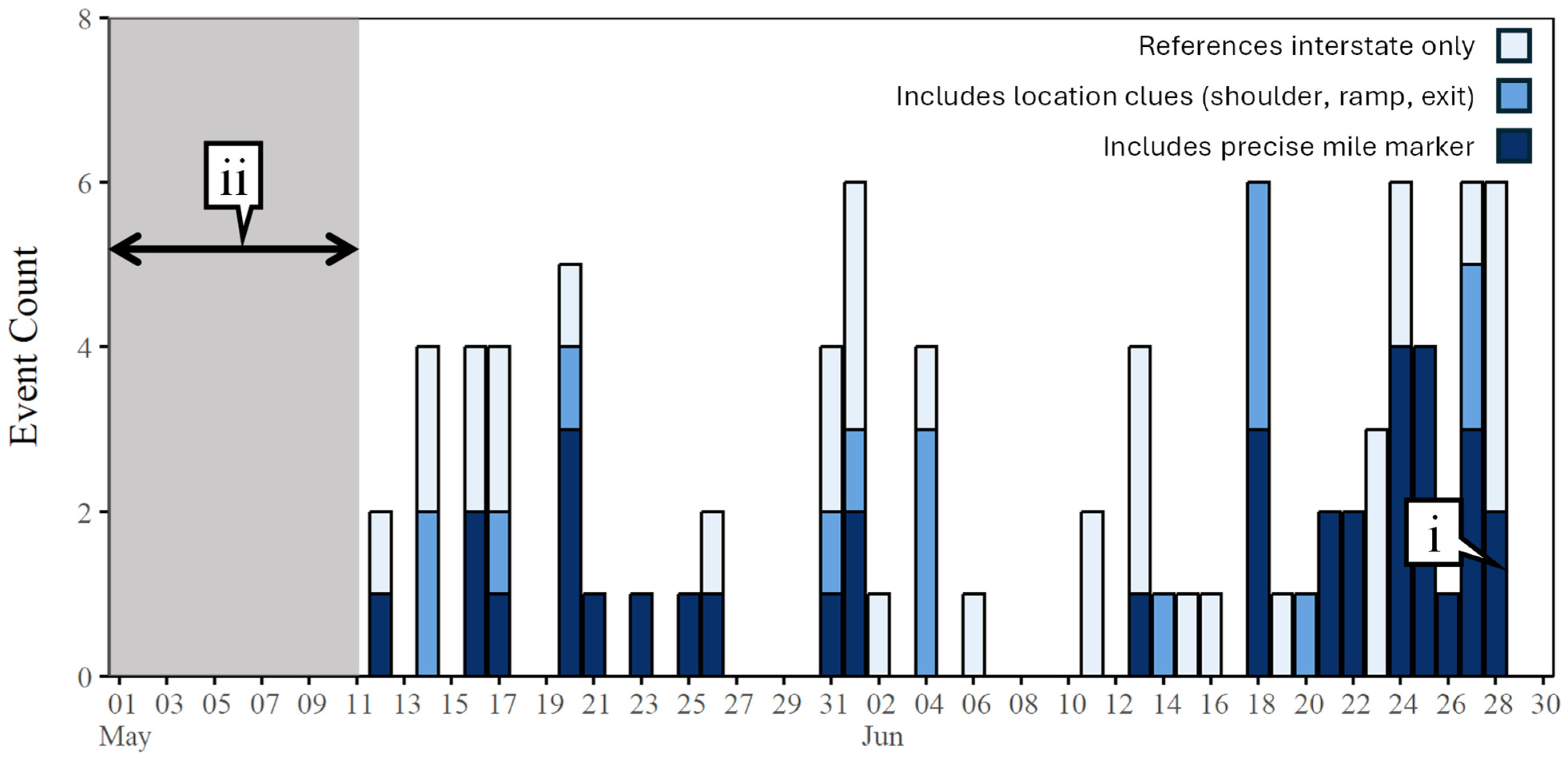
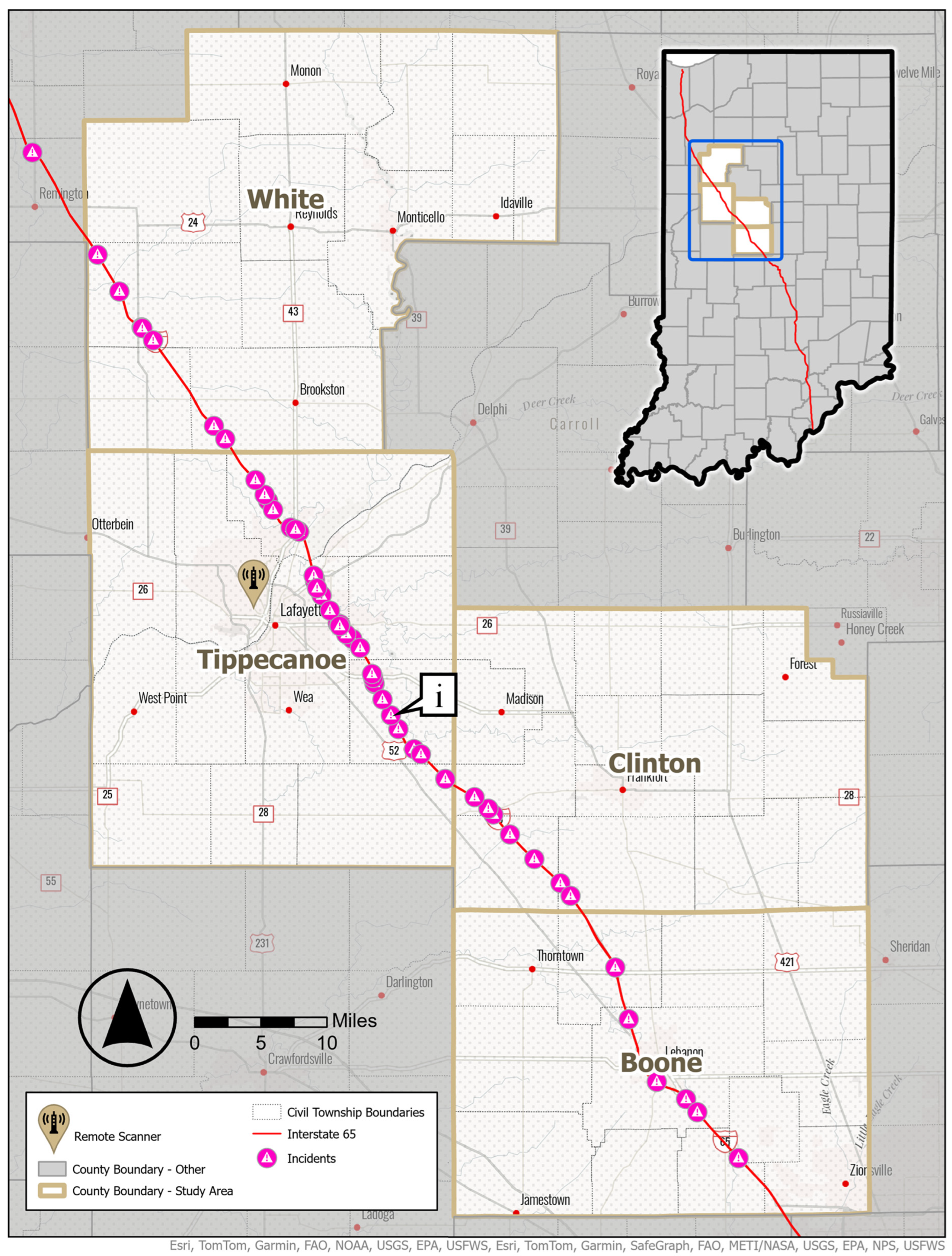
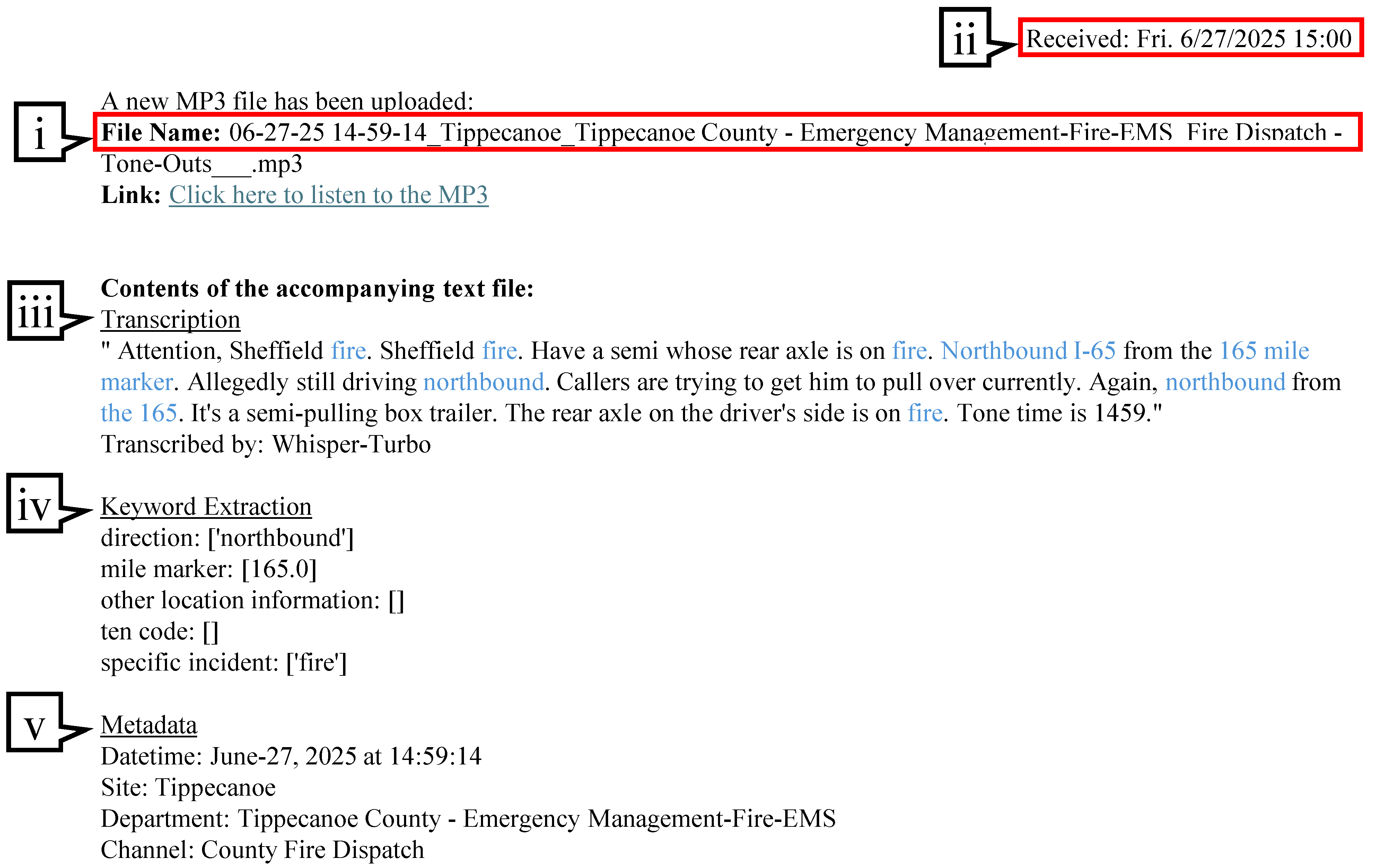
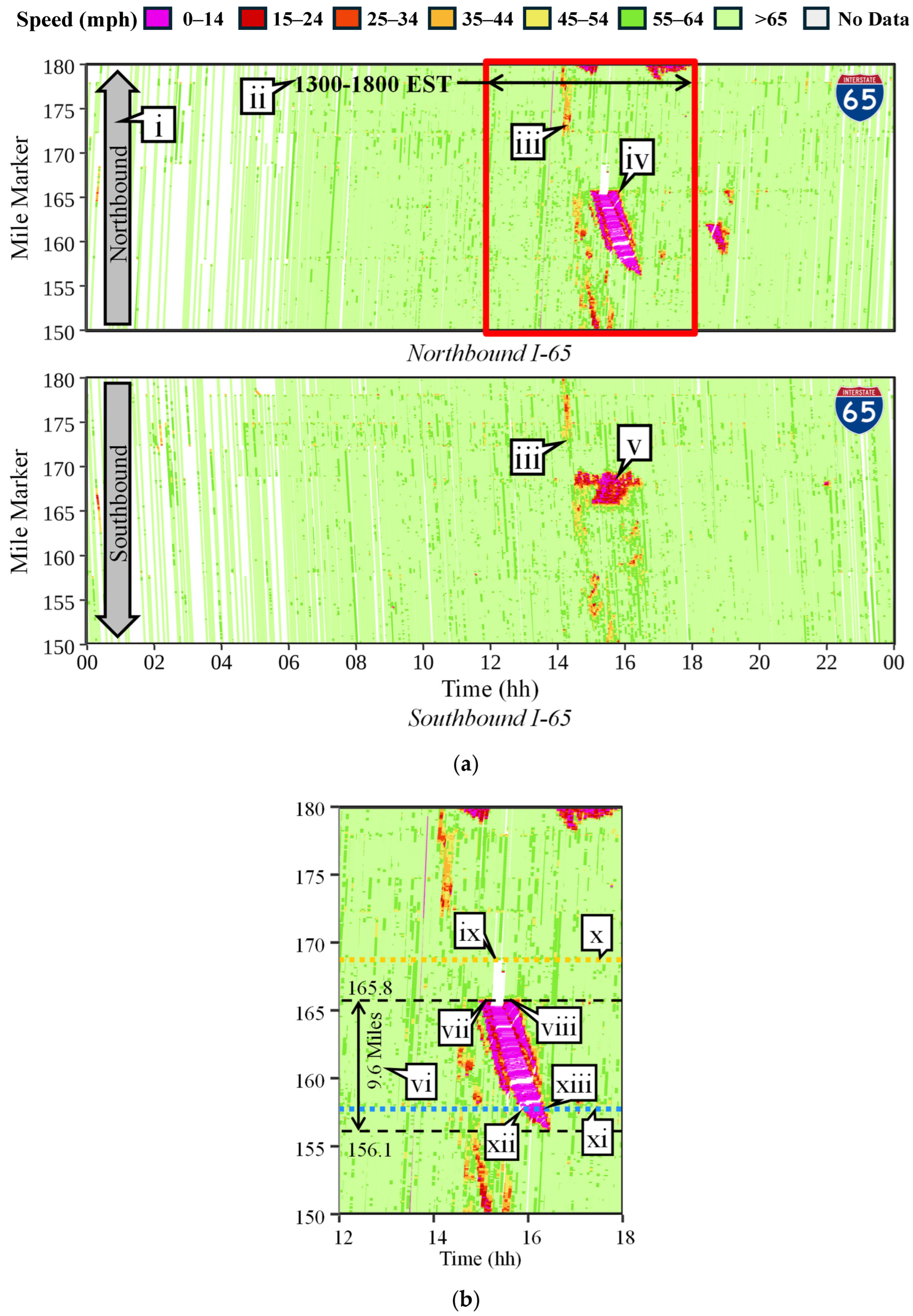
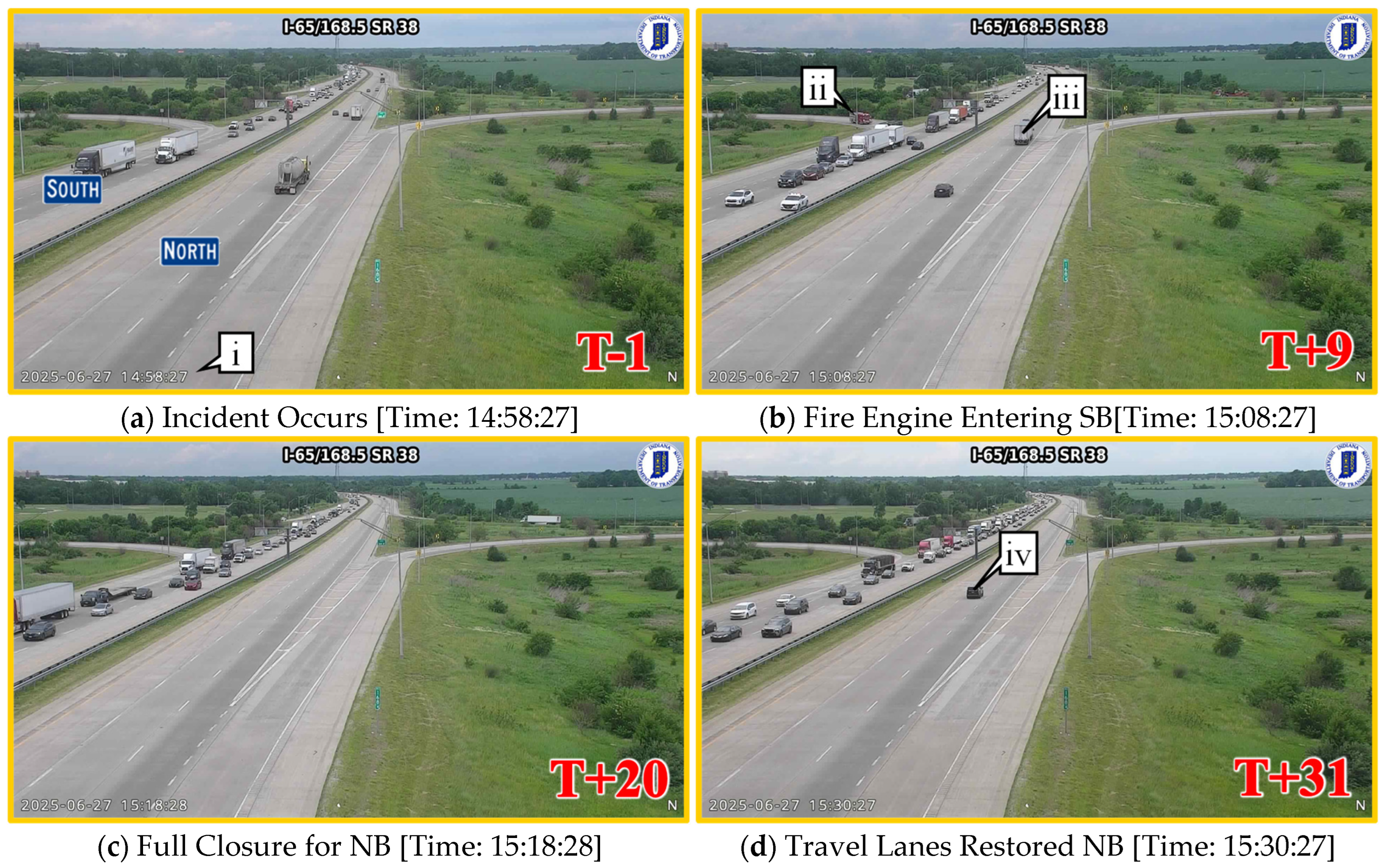

| Time | Channel | Transcription | Action | WER |
|---|---|---|---|---|
| 14:59:14 | Co. Dispatch | Attention Sheffield fire. Sheffield fire. Have a semi whose rear axle is on fire. Northbound I-65 from the 165 mile marker. Allegedly still driving northbound. Callers are trying to get him to pull over currently. Again northbound from the 165. It’s a semi-pulling [a] box trailer. Rear axle on the driver’s side is on fire. Tone time is 1459. | Dispatch broadcasted [Automated Notification Trigger] | 0.02 |
| 15:06:12 | Co. Dispatch | 204 [en] route [with] 2. 204. | Units en route | 0.5 |
| 15:08:08 | Sheffield FD | 204 on Sheffield. | 0.0 | |
| 15:08:20 | Sheffield FD | To the [interstate] until we find out where we’re going. | 0.0 | |
| 15:09:40 | Co. Dispatch | I’m on the phone with the semi-driver now. He’s pulled over. Looks like near the [Wyandot] overpass. [Advising] tandems are still on fire. | Location Confirmed | 0.09 |
| 15:10:05 | Co. Dispatch | 204 is clear [Wyandot] overpass. 206 go ahead and make access to the 65 now. | 0.13 | |
| 15:11:14 | Co. Sheriff’s Office | 23. Go ahead. Do you know where the semi-driver’s [at]? Traffic’s already backed up to the 162. He’s right at the [Wyandot] overpass. Sorry. | Driver Located | 0.13 |
| 15:13:20 | Co. Dispatch | Container fire | 0.50 | |
| 15:13:40 | Co. Dispatch | Tippe. Fire 220. 204 is arriving on scene working fire. 220 will have IC on 65. Northbound they’re going to be shut down by ISP. [] | Units on Scene | 0.08 |
| 15:14:53 | Sheffield FD | 220 40 on Sheffield. We have three on station. What do you want? | 0.00 | |
| 15:16:11 | Co. Dispatch | 206 where do you want me to stage? Stay high [and] forward. Clear. | 0.08 | |
| 15:16:29 | Sheffield FD | 2040 on Sheffield. You want to throw a one or a tanker? | 0.00 | |
| 15:16:43 | Co. Dispatch | We got a good knockdown on it. | Fire out | 0.13 |
| 15:22:08 | Co. Dispatch | In the northbound lanes we’ve got it completely shut down for now. | NB closure | 0.00 |
| 15:22:26 | Sheffield FD | Be southbound and northbound. | SB closure | 0.00 |
| 15:23:42 | Co. Dispatch | One when you arrive just go ahead and get turned around and face back north in front of the. Come on. | 0.00 | |
| 15:28:08 | Co. SO | We can open up the left lane. Sure. | Reopening [NB] lane | 0.00 |
| 15:28:39 | Co. Dispatch | Go ahead. Are they able to open up both lanes or just northbound or southbound? You’ve got a definite block in northbound. He can let the high-speed side go. We’ll keep the low speeds shut down still. | 0.00 | |
| 15:28:58 | Co. Dispatch | Clear. Further southbound slowing is just slow for some reason. Been like that for almost an hour now. | Confirmation SB open | 0.00 |
| 15:29:16 | Co. SO | Got it. We’ll be clear. Clear. | 0.00 | |
| 15:45:03 | Co. Dispatch | Tippe. fire 220. 220. Command [survey] on I-65, all [seems to] be cleared in the scene and service. I’ll move the pressure. Thank you. | Units clear scene | 0.09 |
| Sys. | Department | Channel | Type | MM | Conv | Trun | |
|---|---|---|---|---|---|---|---|
| SAFE-T | State Police Region 1—Lowell | ISP D14 Lafayette Disp. | P | 🚨 | 150–199 | ✓ | |
| ISP D14 Lafayette Multigroup | P | 🚨 | ✓ | ||||
| ISP D14 Lafayette Ops. [1,2,3] | P | 🚨 | ✓ | ||||
| SAFE-T. | White Co. | Co. Fire Disp. | F | 🔥 | 184–199 | ✓ | ✓ |
| Co. (FD) Ops. [1,2,3,4,5,6,7] | F | 🔥 | ✓ | ||||
| Sherrif Disp. | P | 🚨 | ✓ | ||||
| Co. EMS Ops. 2 | E | 🚑 | ✓ | ||||
| Tippecanoe Co. | Tippecanoe Co. Emergency Ambulance Service | EMS Disp. and Alt. | E | 🚑 | 160–184 | ✓ | ✓ |
| Tippecanoe Co. Emergency Mngmt. | Disp. | G | 🏛️ | ✓ | |||
| Tippecanoe Co. S.O. | Disp. | P | 🚨 | ✓ | |||
| Tippecanoe Co. Emergency Mngmt./Fire/EMS | Fire Disp./Tone-Outs | F | 🔥 | ✓ | |||
| Tippecanoe Co. Fire | Disp. | F | 🔥 | ✓ | |||
| Fire Mutual Response Area | F | 🔥 | |||||
| Battleground FD | F | 🔥 | 176–184 | ✓ | |||
| Lafayette FD | Sta. 6 Ops. | F | 🔥 | 174–176 | ✓ | ||
| Sta. 5 Ops. | F | 🔥 | 172–174 | ✓ | |||
| Sta. 9 Ops. | F | 🔥 | 170–172 | ✓ | |||
| Sta. [2,7] Ops. | F | 🔥 | * | ✓ | |||
| Tippecanoe Co. Fire | Sheffield FD | F | 🔥 | 160–170 | ✓ | ||
| Clark Hill FD | F | 🔥 | * | ✓ | |||
| SAFE-T | Clinton Co. | Co. Fire Disp. | F | 🔥 | 150–160 | ✓ | ✓ |
| Co. Law Enforcement Disp. [1,2] | P | 🚨 | ✓ | ✓ | |||
| SAFE-T | Boone Co. | Co. EMA/EMS Ops. | E | 🚑 | 128–150 | ✓ | ✓ |
| Co. Fire Disp. | F | 🔥 | ✓ | ✓ | |||
| Co. Fire Ops. [1,2,3,4,5] | F | 🔥 | ✓ | ||||
| Sherrif Disp. [1,2] | P | 🚨 | ✓ | ||||
| (F)🔥: Fire; (P)🚨: Law Enforcement; (E)🚑: EMS; (G)🏛️: Government/Other | * Mutual Aide Only | ||||||
| Keyword Group | Examples | Description |
|---|---|---|
| “Interstate” | “interstate”, “the i”, “i-65”, “65” | Common and local phrase extraction for Interstate 65 (I-65) running through the study area. |
| “Location” | “168.5 northbound”, “155 mile marker”, “exit”, “left shoulder” | The locational information contained within the call. Information includes interchange features, linear reference markers, and directionalities. |
| “Incident” | “10–50/51”, “PI (Personal Injury)”, “crash”, “collision”, “wreck”, “fire”, “medical” | Common coded communications and contextual information about the incident contained within the call. |
Disclaimer/Publisher’s Note: The statements, opinions and data contained in all publications are solely those of the individual author(s) and contributor(s) and not of MDPI and/or the editor(s). MDPI and/or the editor(s) disclaim responsibility for any injury to people or property resulting from any ideas, methods, instructions or products referred to in the content. |
© 2025 by the authors. Licensee MDPI, Basel, Switzerland. This article is an open access article distributed under the terms and conditions of the Creative Commons Attribution (CC BY) license (https://creativecommons.org/licenses/by/4.0/).
Share and Cite
Gartner, C.M.; Vajpayee, V.; Desai, J.; Bullock, D.M. Automatic Speech Recognition of Public Safety Radio Communications for Interstate Incident Detection and Notification. Smart Cities 2025, 8, 157. https://doi.org/10.3390/smartcities8050157
Gartner CM, Vajpayee V, Desai J, Bullock DM. Automatic Speech Recognition of Public Safety Radio Communications for Interstate Incident Detection and Notification. Smart Cities. 2025; 8(5):157. https://doi.org/10.3390/smartcities8050157
Chicago/Turabian StyleGartner, Christopher M., Vihaan Vajpayee, Jairaj Desai, and Darcy M. Bullock. 2025. "Automatic Speech Recognition of Public Safety Radio Communications for Interstate Incident Detection and Notification" Smart Cities 8, no. 5: 157. https://doi.org/10.3390/smartcities8050157
APA StyleGartner, C. M., Vajpayee, V., Desai, J., & Bullock, D. M. (2025). Automatic Speech Recognition of Public Safety Radio Communications for Interstate Incident Detection and Notification. Smart Cities, 8(5), 157. https://doi.org/10.3390/smartcities8050157





